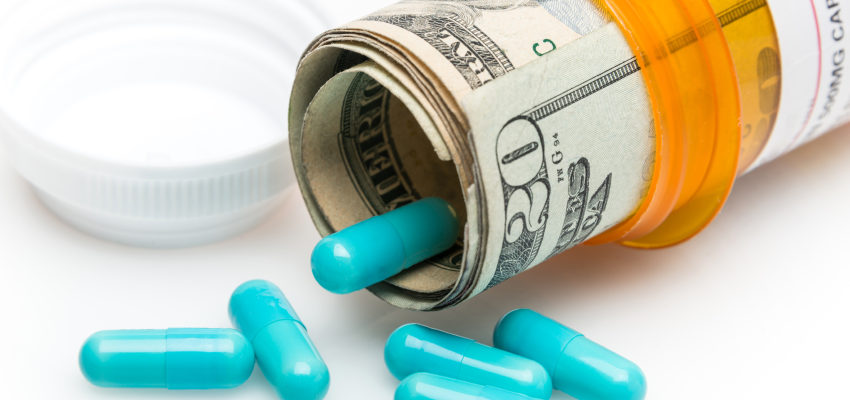In late January, after a White House meeting with pharmaceutical industry executives, President Trump declared that although U.S. drug companies “have produced extraordinary results for our country, the pricing has been astronomical.” As a candidate, Trump had also vowed to lower high drug costs. Just days ago, he again tweeted about his concerns over the issue.
I am working on a new system where there will be competition in the Drug Industry. Pricing for the American people will come way down!
— Donald J. Trump (@realDonaldTrump) March 7, 2017
These concerns over escalating brand-name drug prices are completely real. In February, Kaleo Pharmaceuticals increased the price of its anti-opiod injector Evzio from $690 to $4,500, leading to a blistering inquiry by 31 U.S. senators who complained that “such a steep rise” threatens to “price out families and communities” at a time when “addiction to heroin and other opiods has reached epidemic levels.” And Marathon Pharmaceuticals recently announced it would launch a medication used to treat muscular dystrophy in the U.S. market — shortly after its final approval by the FDA — at a price tag of $89,000 a year, despite being available for decades in Europe at a fraction of the cost.
Those may be isolated instances of price gouging, but they illustrate a serious, real-world pricing problem in prescription drugs. According to healthcare publication OncologyLive, for instance, the cost of treating one patient with cancer for a year rose from $100,000 in 2012 to $150,000 in 2014. The cost of cancer drugs sold in the U.S. more than doubled in just five years from $16 billion in 2010 to $38 billion in 2015.
With statistics like these, policy makers have only a few real options. One is to impose a system of mandatory price regulation on prescription drug sales in the United States. That would seem quixotic in light of this nation’s strong commitment to free markets and wide philosophical opposition to both single-payer healthcare and historically ineffective rate regulation by government agencies.
The second option, in contrast, is more realistic and holds the potential to be very effective: jump-start generic competition by removing industry and regulatory barriers facing generic drug firms getting safe, less expensive products into the market more quickly.
Unfortunately for consumers, brand-name drug manufacturers are using strategies to extend their profits and deny would-be generic competitors the tools and resources required to meet FDA safety rules to manufacture generic versions of expensive drugs after their patents have expired.
These strategies take two forms. First, refusing to sell products and samples to generic firms wanting to establish to the FDA that the active ingredients in their products are essentially the same as (“bioequivalent” or “biosimilar” to) an approved branded drug. Second, the refusal to enter into risk-mitigation sharing agreements for certain drugs with potentially serious risks for which distribution is restricted by regulation for safety purposes. The latter aims to prevent generic competitors from satisfying the legal requirement to participate in what the FDA terms a Risk Evaluation and Mitigation Strategies (REMS) program.
These twin tactics are a predictable result of the monopoly power resulting from pharma patents and the incentive of brand manufacturers to protect that power after patent expiration. According to a July 2014 study conducted by Matrix Global Advisors, ongoing REMS abuse by brand-name drug companies cost the U.S. health system $5.4 billion annually — $1.8 billion to the federal government alone.
A bipartisan group of legislators has devised a straight-forward fix for this multi-billion dollar problem. Before the election, a bill dubbed the CREATES Act (an acronym for Creating and Restoring Equal Access to Equivalent Samples) was introduced by Sens. Mike Lee (R-UT), Chuck Grassley (R-Iowa), Pat Leahy (D-Vt.) and Amy Klobuchar (D-Minn.).
The CREATES Act would clarify that branded pharma manufacturers’ sample denial — declining to “provide sufficient quantities” of a branded drug to a generic developer “on commercially-reasonable, market-based terms” — or refusal to allow participation in a “single, shared” risk distribution system works against the public interest and should be remedied.
Under the bill, FDA is charged with setting up a system to satisfy concerns that the generic company can comply with safety requirements and that they are expected to act according to the law. Once conditions are met, and because production of generic drugs is statutorily authorized and generic competition is in the public interest, the brand company must sell samples to the generic developer. If the brand company fails to comply under the “sample sale” provision, the proposal provides a simple enforcement mechanism; a judicial injunction and possible monetary damages.
Some may debate whether permitting more private litigation is the optimal means of encouraging market competition, but we are dealing here with a highly imperfect, heavily regulated drug and healthcare market. It is doubtful critics could legitimately argue that price regulation is superior, and the slow pace of FDA proceedings is a poster case of Washington inefficiency. So while handing off the principal remedies for generic competition to the federal courts in specific, narrow circumstances may ruffle some conservatives’ feathers, that is essentially the same way the American antitrust and patent laws have worked for more than a century, including in the pharmaceutical industry.
The CREATES Act is set to be re-introduced as soon as this week. By harnessing the business incentives of generic drug firms to limit the anticompetitive power of branded pharmaceutical patent holders, the CREATES Act represents a straight-forward solution to a market failure created by exploitation of legal loopholes in drug industry regulation. It is a remedy that should be strongly supported by the White House and enacted by the new Congress.
Published in The Hill (March 16, 2017)

